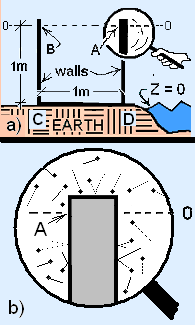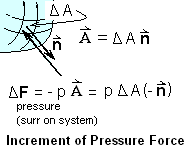| THERMO Spoken Here! ~ J. Pohl © | TOC NEXT ~ 64 |
2.00 Ideal Fluids
The Greeks generalized matter as being "solid" or "fluid." Today "fluid," means either "liquid" or "gas" and a "gas" is either "a gas" or an "ideal gas." For the purposes of engineering, fluids as liquids and gases have proven more difficult to understand and describe. An early and current model, an logical approximation of fluids, that is in their motions behavior in its used has been the approximation that matter that flows in fluid motion (in disregard of fact) was that flowing fluids experience no friction.
Fluids as they move (liquids or gases, or a combination of there-of) experience friction in two manners. Friction attends fluid motion in its interior. Frictional effects interior to the system (within the flowing fluid), internal, within the boundary of the moving fluid. Fluid friction exists. But sometimes, especially with first-level fluid-analysis calculations, the fluid is modeled as "Ideal," meaning, "without internal friction."
Some 2000 years ago philosophers supposed that all matter consisted
 as aggregates of very small, invisible components of matter which they called atoms. Two distinct forms were identified: solid or fluid. Fluids were further classified as being either liquid or gas. With regard to fluid properties, the Greeks and later investigators (until around 1650) understood volumes and masses of the liquids but only the volumes of gases. The ancients had beginning ideas of pressure, not directly as pressure, but as it changed with their activities and the weather. Greeks, as they dove in the Mediterranean and Aztecs moving through the Andes felt their ears pop as the ambient pressures changed.
as aggregates of very small, invisible components of matter which they called atoms. Two distinct forms were identified: solid or fluid. Fluids were further classified as being either liquid or gas. With regard to fluid properties, the Greeks and later investigators (until around 1650) understood volumes and masses of the liquids but only the volumes of gases. The ancients had beginning ideas of pressure, not directly as pressure, but as it changed with their activities and the weather. Greeks, as they dove in the Mediterranean and Aztecs moving through the Andes felt their ears pop as the ambient pressures changed.
Fluid Particles, Behaviors and Properties: Sketch a) depicts air at a typical location on Earth at sea level (z = 0). Two walls extend upward from Earth into the air a height of one meter. Atmospheric air bounds the walls on their sides and above and fills the space between them.

Consider a cubic meter of air defined imaginary, Sketch a), as the one meter by one meter square in the plane of the page (A-B-C-D) and one meter of depth into the page. Modern physics has established that on average in time that space between the walls contains some 25 x 1021 particles.
That is an enormous number of particles but the particles (mostly diatomic nitrogen and oxygen), are so very small that more than 99.99% of the space of the cubic meter is void of matter. We see through air because its particles occupy scarcely 0.01 percent of the space it exists within.
Sketch b) depicts part of the physical situation seen through a very powerful magnifying glass. One wall is seen from its end; the particles of air in its vicinity immensely exaggerated in size. and vastly reduced in number. The few particles are depicted as moving in all directions at speeds as fast as 1000 miles per hour. Obviously some of these particles will collide with, we say, "impact" the wall; and others will cross the plane 0 - 0 moving into the space as others at the same rate cross plane 0 - 0 leaving the space.
Some facts about the particles, the wall and the plane 0 - 0 are:
- Very many particles impact the wall continually. The impacts are so many (over every tiny area of wall and over every nanosecond of time) that there is never an instance over which a million or so impacts are not occurring. Nor is there any area of the wall, however small, for which there is not continual impacting of particles.
- The particles arrive to impact the wall wit velocities in all possible directions. For every million particles arriving from one direction there is a million that arrive to impact from an "opposite" (or mirror-image) direction.
- Newton studied "bodies in motion without friction." His Second Law of Motion with its construct, force, applied readily to the system models BODY or point mass. His conclusions extend in a natural way to "fluid motion without friction." The new model perspective required is the "ideal fluid," which is "deformable and uniformly distributed." Also, to deal with fluid motion requires modification of the construct, force. Systems of ideal fluids either flow (or do not flow) in accord with acting gravity (a body force) and boundary forces (or constraints) of the surroundings. Boundary forces are characterized as pressure forces.
- The collection of particles is called a continuum. The collection continuously experiences momentum change at its boundaries. The consequence of as many impacts coming for one direction as its opposite results in the net or vector sum of forces from the boundary being perpendicular to it. The sum of all components of impact force not perpendicular to the boundary is zero.
Fluid Density and Specific Volume: The fluids we will study are uniformly distributed (some say homogeneous). An amount of homogeneous fluid has a mass, say mfluid. In addition the mass occupies space; let the volume be noted as Vfluid. Given these two numbers, the density of the fluid (notated by the symbol: ρfluid) equals the their ratio

The definitions apply to the homogeneous fluids. Specific volume is simply the reciprocal of density. The "reciprocal property" is useful for fluids with densities numerically less than one. The table lists some common, standard densities of substances.
| DENSITY (@ 1 atm, 25°C) | |
| Substance | Density ~ kg/m3(lbm/ft3) |
| air | 1.2 kg/m3 (0.075) |
| water (liquid) water (solid) |
1000 kg/m3 (62.4) 920 kg/m3(490) |
| mercury | 13560 kg/m3 (?) |
| sea water | 1025 kg/m3 (64) |
| Earth soils | 1920 kg/m3 (120) |
| concrete | 2400 kg/m3 (150) |
| iron or steel | 7850 kg/m3 (490) |
| Use Water for Unit Conversions 1000 kg/m3 ≡ 62.4 lbm/ft3 | |
Pressure and Area At the fluid system boundary the outer collection of particles impact it and exchange momentum with it. That is, particles have vector momentum toward the wall and upon impact their momentums are directed away from the wall. There is a "force effect" that occurs to the continuum of particles. This effect is associated with wall area, is called pressure and is defined as:

Pressure Force The combining of the "force effect" of momentum exchange and the boundary area over which is this occurs is complicated by the fact that both the "force effect" and area are vectors. The result we will call a pressure force and represent it on systems as small arrows directed toward the system and distributed over surface locations. Pressure is not a force. The small arrows represent the product of the pressures at localized places on the boundary times the very small areas over which they acts.

This will become clear in usage.
Gravity Force: A final consideration of ideal fluids is the distributed gravity forces they experience. The attraction of gravity acts over the body of a fluid system. Gravity force is not a property, pre se. However sometimes a fluid is viewed as existing in a gravitational field, thereby having potential energy consequent to its position on Earth rather than gravitational attraction.
The understanding of pressure entails its physical description, pressure terminology and an introduction to measurement devices and methods. The above will suffice for physical description.

2.00 Ideal Fluids
Of the behaviors of phases of matter, fluids (as the Greeks classified liquids and gases) have been the most difficult to describe. An early approximation of fluid behavior (in disregard of fact) was to ignore that flowing fluid matter experiences friction.
Premise presently unwritted!